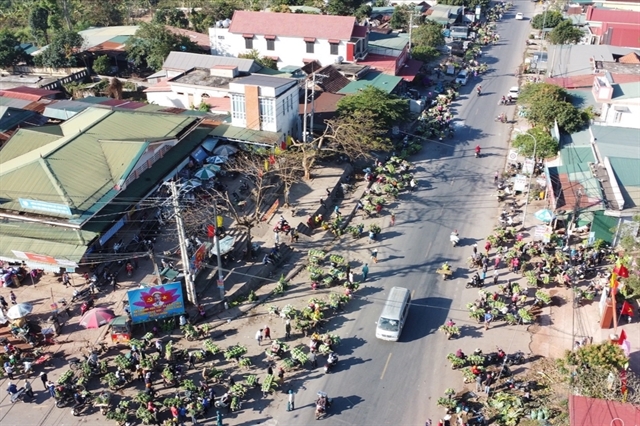
QUẢNG TRỊ — Affected by COVID-19, numerous communes in Quảng Trị Province have been unable to meet the requirements for becoming ‘new-style rural areas.’
To overcome this, local people and authorities have been developing new solutions.
In the mountainous commune of Tân Long in Quảng Trị Province, more than 65 per cent of the population are ethnic minorities.
In efforts to improve its people’s quality of life by 2016, Tân Long Commune has fulfilled all 19 criteria required to become a new-style rural area related to infrastructure, irrigation, electricity, environment, income, education, healthcare, social security and culture.
For years they have been focusing on growing chuối mật mốc – a banana variety of high economic value, significantly increasing local incomes.
Addressing the issue of limited agricultural land, Tân Long people have been collaborating with people in Laos to grow these banana trees in the neighbouring country.
The collaboration went well until COVID-19 broke out and border restrictions barred farmers from going to Laos to harvest the ripened bananas, which meant local incomes plummeted.
In 2019, the commune’s per capita income was VNĐ38 million (US$1,660) per person per year, just enough to meet the requirement. This number dropped to VNĐ29 million ($1,267) in 2020.
Despite the increase to VNĐ35 million ($1,530) in 2021, Tân Long has been unable to fulfil a criterion of a new-style rural zone for the past two years.
Speaking to Dân tộc và Phát triển (Ethnicity and Development) newspaper, Tân Long Commune Party Secretary Võ Tấn Lộc said: “The local Party, authorities and people of Tân Long have been making every effort. However, we could not maintain the required per capita income as a new-style rural area.”
In 2021, Quảng Trị Province recorded 18 communes that failed to maintain up to two criteria required for new-style rural areas.
Among these, three communes of Tân Long, Tân Liên, and Tân Thành in Hướng Hóa District fulfilled all the criteria in the years before. The other 15 communes in Hướng Hóa and Đakrông districts are also striving to become new-rural style areas.
Working around the problems, the people of Tân Long have switched the focus to intensive farming on their own land.
In the past, the family of Lê Trọng Dương in Mông Quy Village grew 8 million banana trees on their one-hectare land, as they needed to save the resources for the plantation in Laos.
Now they are cultivating 20 million banana trees on their farm in Việt Nam. Investments in human resources and appropriate fertilisers have also increased productivity and income.
In addition to banana cultivation, Dương’s family has also branched out to raise cattle. Their 180-cow farm now brings an average monthly income of VNĐ30 million (US$1,311).
Currently, the commune has more than 30 households participating in this livestock farming model, with a total of 1,600 cows.
No longer dependent on the banana farms in Laos, the Bru ethnic people in Tân Long have found ways to diversify their income sources.
In the long run, the new economic models are expected to help maintain the per capita income required and other criteria for new-style rural areas.
Lê Trọng Dương, Chairmain of Tân Long People’s Committee said: “In 2022, our goal is to increase the per capita income to VNĐ41 million ($1,793) per person per year.
“With the cattle-raising model and banana production and processing cooperatives, we are certain that we will achieve our goal.” — VnExpress News
- Reduce Hair Loss with PURA D’OR Gold Label Shampoo
- Castor Oil Has Made a “Huge” Difference With Hair and Brow Growth
- Excessive hair loss in men: Signs of illness that cannot be subjective
- Dịch Vụ SEO Website ở Los Angeles, CA: đưa trang web doanh nghiệp bạn lên top Google
- Nails Salon Sierra Madre
 VnExpress News The News Gateway of Vietnam
VnExpress News The News Gateway of Vietnam





